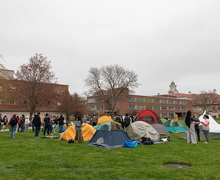Combining race, ethnicity on U.S. Census will lead to systematic erasure
Cole Ross | Digital Design Editor
The 2030 national census will combine race and ethnicity into one question. Our columnist argues that this will undo years of work that brings light to non-white Latines both within and outside of the community.
Get the latest Syracuse news delivered right to your inbox.
Subscribe to our newsletter here.
For as long as I can remember, the Latine community has struggled to reconcile the differences between race and ethnicity. My own family has been forced to have difficult conversations about colorism, racism, xenophobia and what it means to have white privilege when Anglo-American society doesn’t recognize white Latines as white.
I, too, have been called to think about my identity, how I’m perceived and both the setbacks and powers I hold as I move through the world.
This refusal of many to acknowledge their whiteness bleeds into every aspect of their lives, from how they interact with other marginalized groups, to how they think about systematic oppression, to how they answer seemingly simple questions on the annual census.
With the next census coming up in 2030, the White House has recently approved changes to combine race and ethnicity into one question, inaccurately positing Latino/Hispanic as a race and undoing the years of work that’s been done to bring greater visibility to non-white Latines both within and outside of the community.
For decades before this, the U.S. Census Bureau has organized race and ethnicity as two separate categories, listing Latino/Hispanic as an ethnicity and White, Black or African American, American Indian or Alaska Native, Asian, Native Hawaiian or Other Pacific Islander and “other” as races. To spell it out even more, they also include the options for white, non-Hispanic and white, Hispanic.
Under this current categorization system, the census acknowledges that Latines may be of any race and, specifically, that Afro-Latines, Indigenous Latines, Asian Latines and Middle Eastern Latines can and do exist – which is unequivocally a good thing because it makes the visibility of people of color that much more prominent.
There are a whole heap of other issues with the new version we’ll see in 2030, like the fact that they only list six Latin American countries under Hispanic/Latino when there are, in fact, 33. They also listed Haitian under Black/African American when Haiti is considered part of Latin America.
From my perspective, this was done to make white Latines comfortable. Because for many of them, answering the first part is easy. But, it’s the second part that causes confusion, uncertainty and even anger because the majority of white Latines will not identify themselves as white.
This is especially true if they have been targets of xenophobia (which is often confused with racism), if they don’t identify culturally with Anglo-American society, if they want to deny their European colonist heritage or if they believe that they are of Indigenous or African descent based on their skewed understanding of the Latin American history.
Unfortunately, these beliefs and behaviors are common and widespread. In 2020 alone, analysts found that 44% of Latines marked “other” or left the question blank altogether and that 94% of census takers who responded “other” were Latines. Personally, I can’t tell you how many times my family members have voiced this inner conflict of not wanting to identify as white on government documents because it doesn’t feel “true” or “authentic to them.”
To a certain extent, I do understand the frustration. Throughout history and today, Latines, even white Latines, have been consistently racially targeted and oppressed by Anglo-Americans in similar ways to other communities of color. I’ve known relatives who grew up in the 60s when Jim Crow laws forced both Latine and Black community members to sit at the back of the bus and go to segregated schools.
I’ve seen photos of the infamous signs from Texas that read “We Serve White’s Only – No Spanish or Mexicans” and “No Dogs, Negros or Mexicans.” In addition to the horrific dehumanization of equating these two groups with animals, this also equates Mexicans with every other nationality in Latin America and makes a clear racial distinction between white people and Latines.
And yet, there is a simultaneous history of Mexican Americans specifically wanting to be categorized as white. In the 1930s, they protested in vast numbers when “Mexican American” was classified as a race and forced the next census to recognize them as white. This was likely because of the disadvantages they faced when they were othered within Anglo-American culture, society and media. Another layer of this is their own potential racism toward other minority groups that they didn’t want to be equated with.
We’ve seen this happen to other immigrant groups as well like Irish Americans and Italian Americans, where historical oppression disappears as the definition of whiteness expands and evolves over time.
Go even further back, and the original period of European conquest in Latin America was characterized by a common goal of “mestizaje,” or to create a near-total white and mixed-race utopia where race no longer existed through murder, violence and genocide of Black and Indigenous communities. Historically, we have always wanted whiteness.
The legacy of race and ethnicity in the Latine community is long and complicated, unfortunately without any obvious resolution. What is clear to me, however, is that the problem isn’t actually the census at all. I’d argue that the heart of this long-standing question is white Latines and how they’ve been socialized to believe that their identity is removed from systems of white supremacy and anti-Blackness.
How they distance themselves from their own privilege when they are, more often than not, perpetuating the same harmful attitudes that they believe they’re victims of. How they deny the very history of Latin America so they are able to claim oppression, then turn around and oppress other groups of people who have also been racialized in this country.
It’s frustrating that the U.S. Census Bureau director, Robert L. Santos is the first Latine to lead the department, yet he is to blame for this harmful and unnecessary change.
If nothing else, this new census is going to make it that much more difficult to recognize and combat racism and anti-Blackness. It’s going to undo years of conversations we’ve had as a community to understand the differences between race and ethnicity and unlearn the myths we’ve been told all our lives. If the goal was to give us representation, make progress and address a historic lineage of pain and erasure, I can say that this wasn’t the way to do it.
Sofia Aguilar is a first-year grad student in the Library and Information Science program. Her column appears weekly. She can be reached at saguilar07@syr.edu.
Published on April 3, 2024 at 11:25 pm





